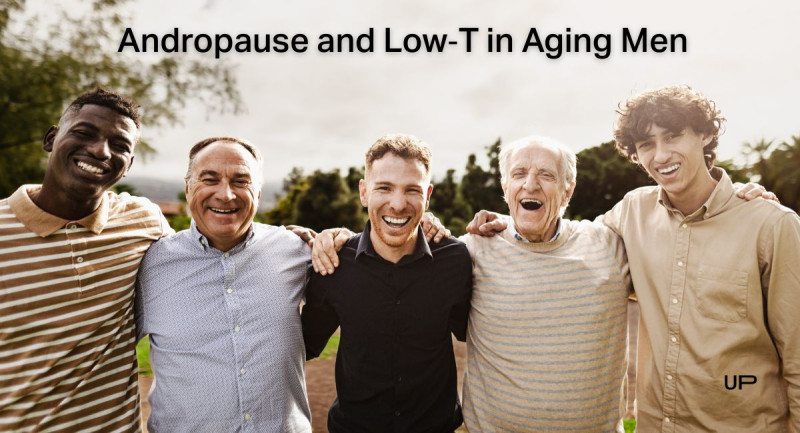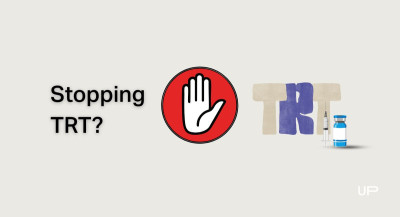Andropause And Low‑T In Aging Men: Diagnosis, Risks & Science‑Backed Management


Andropause, also known as late-onset hypogonadism, refers to the gradual decline of testosterone levels in men as they age, often beginning in their 40s or 50s.

Unlike the abrupt hormonal shift women experience during menopause, andropause is more subtle but no less impactful.
Testosterone levels drop about 1% per year after age 30, and by the time many men reach their 60s, levels can be low enough to cause real symptoms: low libido, fatigue, mood changes, reduced muscle mass, and even cognitive decline.
In Canada, awareness of andropause is growing, as more men seek answers for unexplained changes in energy, mood, and performance.
This has led to increased interest in testosterone replacement therapy (TRT) in Canada. However, many men still don’t know when low testosterone is a medical issue versus a natural part of aging.
Understanding the science behind hormonal decline is essential to making informed, safe, and effective decisions about your long-term health.
Topics covered in this article:
Physiology & Mechanisms of Low‑T in Aging
Testosterone doesn’t just drop randomly with age — it’s tied to several biological changes in the body. From how well your testicles respond to hormone signals to the way your body handles binding proteins and inflammation, multiple systems influence how much usable testosterone you have.

Here's what happens under the hood:
Leydig cell aging and reduced responsiveness to LH
- As men age, Leydig cells, the testicular cells responsible for testosterone synthesis, undergo structural and functional decline.
- Aging Leydig cells show lower expression of steroidogenic enzymes (e.g., StAR, CYP11A1, CYP17A1) and diminished cAMP signalling in response to LH stimulation.
- The sensitivity of Leydig cells to LH declines with age. In older men, the testosterone output per LH stimulus is lower than in younger men, indicating impaired coupling between LH signalling and androgen production.
- Some studies implicate stress‑activated kinases (e.g. p38 MAPK) in accelerating Leydig cell senescence and impairing steroidogenesis via oxidative stress and inflammatory pathways.
Increased SHBG & altered androgen receptor sensitivity
- With aging, sex hormone‑binding globulin (SHBG) levels tend to rise, which reduces the fraction of free (bioavailable) testosterone.
- Higher SHBG means that even if total testosterone is in a borderline range, the free (active) testosterone may fall below the threshold for symptom relief.
- Meanwhile, androgen receptor function may decline with age (e.g. receptor density, signalling efficacy), making tissues less responsive to a given level of testosterone.
Role of comorbidities (obesity, insulin resistance, inflammation) in accelerating decline
- Obesity is strongly associated with lower testosterone in men, and is considered one of the key contributors to male hypogonadism in clinical populations.
- Mechanisms linking obesity to lower T include increased aromatization of testosterone into estradiol in adipose tissue, altered leptin and adipokine signalling, and disruption of the hypothalamic‑pituitary‑testicular axis.
- Insulin resistance and metabolic syndrome often coexist with aging, and chronic low‑grade inflammation and oxidative stress can damage testicular cells, impair steroidogenesis, and accelerate Leydig cell aging.
- Some animal and human data show that elevated inflammatory mediators (e.g. IL‑6) correlate with lower testosterone, and inflammation may suppress Leydig cell function independently of LH signalling.
Symptoms & Clinical Presentation
Andropause, or age-related testosterone deficiency, presents with a range of physical, emotional, and sexual symptoms. Some are more specific to low testosterone, while others can be mistaken for normal aging or unrelated conditions.
Sexual Symptoms
These are typically the most specific and reliable indicators of low testosterone:
- Low libido or reduced sexual desire
- Erectile dysfunction or weaker erections
- Fewer spontaneous erections (especially morning erections)
Non-Sexual Symptoms
These symptoms are more general and may overlap with other age-related health issues:
- Persistent fatigue or reduced energy
- Depressed mood or increased irritability
- Trouble concentrating or feeling mentally foggy
- Loss of muscle mass or strength
- Increased abdominal fat
- Lower bone density, with increased fracture risk
- Poor sleep quality or insomnia

How Specific Are These Symptoms?
- Sexual symptoms are more likely to indicate testosterone deficiency, especially when several appear together.
- Non-sexual symptoms are less specific on their own and can also be caused by stress, chronic illness, sleep problems, or depression.
Screening Questionnaires
Clinicians sometimes use quick symptom checklists to decide whether testing is appropriate:
- ADAM (Androgen Deficiency in Aging Males): A short questionnaire that covers energy, mood, and sexual function. It's very sensitive, meaning it flags most men who have low testosterone, but also produces many false positives.
- AMS (Aging Males' Symptoms scale): A longer 17-item tool that evaluates symptoms across sexual, psychological, and physical domains. It can help track symptom severity, but it doesn't always match up with testosterone levels.
These questionnaires are helpful first steps, but they’re not enough for a diagnosis. Blood testing and a full medical evaluation are still essential to confirm whether testosterone levels are truly low.
How Low Testosterone Is Diagnosed in Canada
If you're a man over 40 and you're feeling off, tired all the time, not interested in sex like you used to be, or just not feeling like yourself, you might wonder if low testosterone is the reason. Here's how doctors figure that out.
When Should You Get Tested?
You should consider getting your testosterone levels checked if you have:
- Low sex drive or trouble with erections
- Fewer spontaneous (morning) erections
- Constant fatigue that doesn't go away with rest
- Mood swings, feeling down, or mentally foggy
- Muscle loss, weight gain (especially around the belly), or low bone strength
- Type 2 diabetes, obesity, or other long-term health issues
If you check more than one of these boxes, it’s worth talking to your doctor. You won’t be offered treatment just because you're aging; you need real symptoms and confirmed low testosterone levels to qualify for testosterone therapy in Canada.

What Tests Will You Need?
The first and most important test is a total testosterone blood test.
- It should be done in the morning, before 10 a.m., because that’s when levels are highest.
- It needs to be repeated at least twice on different days to confirm the result. Testosterone naturally goes up and down from day to day.
If your results are borderline or unclear, your doctor might also check:
- Free testosterone (the active form your body can actually use)
- LH and FSH (to find out if the issue is in your testicles or brain)
- SHBG (a protein that can affect how much testosterone is available)
- Prolactin, estradiol, and thyroid levels (to rule out other problems)
- PSA (for prostate health), hematocrit, and liver function tests, especially before starting any treatment
What Counts as “Low” Testosterone?
There’s no single “perfect number,” but most Canadian doctors use these guidelines:
- Below 10 nmol/L (about 290 ng/dL): This is usually considered low
- Between 10 and 12 nmol/L: This is a gray zone and symptoms matter more here
- Above 12 nmol/L: Usually not low, unless your free testosterone is very low
Important: Testosterone blood tests can vary depending on the lab and time of day. That's why doctors look at both your symptoms and your bloodwork to make a diagnosis, not just one or the other.
Primary vs Secondary Low T: What’s the Difference?
- Primary low T means your testicles aren’t making enough testosterone, even though your brain is telling them to.
- Secondary low T means your brain (pituitary or hypothalamus) isn’t sending the signal properly.
- Blood tests like LH and FSH help doctors tell the difference, which can affect your treatment plan.
Bottom Line
If you’re dealing with symptoms that don’t feel like “just aging,” and especially if you have sexual changes, don’t ignore them. Talk to your doctor. In Canada, testosterone testing is covered when medically necessary, and guidelines are in place to make sure it’s used safely and effectively.
Risks, Controversies & What the Research Says
Testosterone replacement therapy (TRT) has helped many men with low T feel stronger, more energetic, and more engaged — but it’s not without controversy. Some studies show benefits for sexual function, mood, muscle mass, and bone density. But other research has raised concerns about possible risks, including:
- Increased red blood cell count (which can thicken the blood)
- Prostate health questions, especially in older men
- Possible cardiovascular risks, although the evidence is mixed
There’s also concern about overuse; some men are prescribed TRT even when their testosterone is borderline or normal. That’s why in Canada, guidelines recommend TRT only for men with both consistent symptoms and confirmed low levels on bloodwork.
The bottom line: TRT can help the right person, but it’s not a fix-all. It's important to get properly tested, monitored, and to weigh the risks and benefits with your doctor.
Management Options & Best Practices
If your testosterone is truly low and symptoms are affecting your quality of life, there are effective ways to take control, and it doesn’t always start with a prescription.
1. Start With Lifestyle Changes
Many men can improve testosterone levels and symptoms naturally. Doctors in Canada often recommend these steps before considering testosterone therapy:
- Lose weight, especially around the belly
- Lift weights or do resistance training several times a week
- Sleep 7–8 hours per night on a regular schedule
- Reduce alcohol and stress, which can lower testosterone
- Eat better, a diet rich in healthy fats, protein, and whole foods supports hormone balance
These changes don’t just help testosterone. They boost mood, energy, strength, and long-term health.
2. Testosterone Therapy: What You Need to Know
If lifestyle changes aren’t enough and blood tests confirm low T, your doctor may offer testosterone replacement therapy (TRT). It comes in several forms:
- Gels or creams, applied daily
- Injections, either short-acting or long-acting
- Patches worn on the skin
- Pellets inserted under the skin (less common in Canada)
TRT can improve sex drive, energy, mood, and muscle mass, but only if your testosterone is truly low and you’re closely monitored.
3. Monitoring and Safety
TRT isn’t “set it and forget it.” Your doctor should regularly check:
- Testosterone levels to confirm the dose is working
- Blood counts (hematocrit) to watch for thickened blood
- Prostate health (PSA blood test)
- Cholesterol, liver enzymes, and blood pressure
In Canada, doctors follow clear guidelines to keep TRT safe. If any risk factors show up, the dose may need to be adjusted, or treatment paused.
Talk to Your Doctor First
TRT is not right for everyone. Certain medical conditions may make it unsafe, and self-treatment can do more harm than good. If you’re considering testosterone therapy, speak with a doctor who can guide you through testing, risks, and whether it’s the right option for you.

Conclusion
Low testosterone is real — and for some men, it can seriously impact energy, mood, sex drive, and overall well-being. But it’s not always the cause of how you're feeling, and treatment isn’t a one-size-fits-all solution.
What matters most is getting the full picture: proper blood tests, an honest look at your symptoms, and a doctor who can walk you through the risks and benefits.
If you're over 40 and not feeling like yourself, don't guess. Talk to your healthcare provider. The right information and the right plan can make all the difference.
References
UPGUYS has strict sourcing guidelines to ensure our content is accurate and current. We rely on peer-reviewed studies, academic research institutions, and medical associations. We strive to use primary sources and refrain from using tertiary references.- Andropause: A Neglected Disease Entity, Lidsen,
https://www.lidsen.com/journals/geriatrics/geriatrics-08-02-276 - The Aging Males' Symptoms (AMS) scale: review of its methodological characteristics, PubMed,
https://pubmed.ncbi.nlm.nih.gov/14675485/ - The Association between Inflammation, Testosterone and SHBG in men: A cross-sectional Multi-Ethnic Study of Atherosclerosis, PubMed,
https://pubmed.ncbi.nlm.nih.gov/37221937/ - Clinical and Therapeutic Implications of Male Obesity, MDPI,
https://www.mdpi.com/2077-0383/12/16/5354 - Aging and androgens: Physiology and clinical implications, PubMed,
https://pubmed.ncbi.nlm.nih.gov/36459352/ - The Role of SHBG as a Marker in Male Patients with Metabolic-Associated Fatty Liver Disease: Insights into Metabolic and Hormonal Status, MDPI,
https://www.mdpi.com/2077-0383/13/24/7717 - New Insights in the Diagnostic Potential of Sex Hormone-Binding Globulin (SHBG)-Clinical Approach, PubMed,
https://pubmed.ncbi.nlm.nih.gov/40427034/ - Involvement of p38 MAPK in Leydig cell aging and age-related decline in testosterone, Frontiers,
https://www.frontiersin.org/journals/endocrinology/articles/10.3389/fendo.2023.1088249/full - Age-related testosterone decline: mechanisms and intervention strategies, BMC,
https://rbej.biomedcentral.com/articles/10.1186/s12958-024-01316-5 - Leydig cell aging and hypogonadism, PubMed,
https://pubmed.ncbi.nlm.nih.gov/25700847/
This article is written for informational purposes only and does not constitute medical advice. The information provided in the articles cannot and should not replace advice from a healthcare professional. Talk to your healthcare provider about any physical or mental health concerns or the risks and benefits of any treatment or medication.





